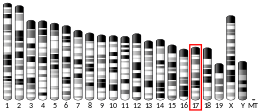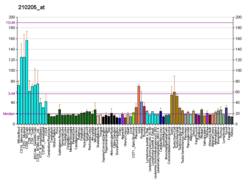B3GALT4
Beta-1,3-galactosyltransferase 4 is an enzyme that in humans is encoded by the B3GALT4 gene.[5][6]
This gene is a member of the beta-1,3-galactosyltransferase (beta3GalT) gene family. This family encodes type II membrane-bound glycoproteins with diverse enzymatic functions using different donor substrates (UDP-galactose and UDP-N-acetylglucosamine) and different acceptor sugars (N-acetylglucosamine, galactose, N-acetylgalactosamine). The beta3GalT genes are distantly related to the Drosophila Brainiac gene and have the protein coding sequence contained in a single exon. The beta3GalT proteins also contain conserved sequences not found in the beta4GalT or alpha3GalT proteins. The carbohydrate chains synthesized by these enzymes are designated as type 1, whereas beta4GalT enzymes synthesize type 2 carbohydrate chains. The ratio of type 1:type 2 chains changes during embryogenesis. By sequence similarity, the beta3GalT genes fall into at least two groups: beta3GalT4 and 4 other beta3GalT genes (beta3GalT1-3, beta3GalT5). This gene is oriented telomere to centromere in close proximity to the ribosomal protein S18 gene. The functionality of the encoded protein is limited to ganglioseries glycolipid biosynthesis.[6]
References
- ENSG00000235155, ENSG00000226936, ENSG00000206285, ENSG00000235863 GRCh38: Ensembl release 89: ENSG00000236802, ENSG00000235155, ENSG00000226936, ENSG00000206285, ENSG00000235863 - Ensembl, May 2017
- GRCm38: Ensembl release 89: ENSMUSG00000067370 - Ensembl, May 2017
- "Human PubMed Reference:". National Center for Biotechnology Information, U.S. National Library of Medicine.
- "Mouse PubMed Reference:". National Center for Biotechnology Information, U.S. National Library of Medicine.
- Amado M, Almeida R, Carneiro F, Levery SB, Holmes EH, Nomoto M, Hollingsworth MA, Hassan H, Schwientek T, Nielsen PA, Bennett EP, Clausen H (Jun 1998). "A family of human beta3-galactosyltransferases. Characterization of four members of a UDP-galactose:beta-N-acetyl-glucosamine/beta-nacetyl-galactosamine beta-1,3-galactosyltransferase family". J Biol Chem. 273 (21): 12770–8. doi:10.1074/jbc.273.21.12770. PMID 9582303.
- "Entrez Gene: B3GALT4 UDP-Gal:betaGlcNAc beta 1,3-galactosyltransferase, polypeptide 4".
External links
- Human B3GALT4 genome location and B3GALT4 gene details page in the UCSC Genome Browser.
Further reading
- Amado M, Almeida R, Schwientek T, Clausen H (2000). "Identification and characterization of large galactosyltransferase gene families: galactosyltransferases for all functions". Biochim. Biophys. Acta. 1473 (1): 35–53. doi:10.1016/S0304-4165(99)00168-3. PMID 10580128.
- Otsuki T, Ota T, Nishikawa T, et al. (2007). "Signal sequence and keyword trap in silico for selection of full-length human cDNAs encoding secretion or membrane proteins from oligo-capped cDNA libraries". DNA Res. 12 (2): 117–26. doi:10.1093/dnares/12.2.117. PMID 16303743.
- Gerhard DS, Wagner L, Feingold EA, et al. (2004). "The Status, Quality, and Expansion of the NIH Full-Length cDNA Project: The Mammalian Gene Collection (MGC)". Genome Res. 14 (10B): 2121–7. doi:10.1101/gr.2596504. PMC 528928. PMID 15489334.
- Mungall AJ, Palmer SA, Sims SK, et al. (2003). "The DNA sequence and analysis of human chromosome 6". Nature. 425 (6960): 805–11. doi:10.1038/nature02055. PMID 14574404.
- Strausberg RL, Feingold EA, Grouse LH, et al. (2003). "Generation and initial analysis of more than 15,000 full-length human and mouse cDNA sequences". Proc. Natl. Acad. Sci. U.S.A. 99 (26): 16899–903. doi:10.1073/pnas.242603899. PMC 139241. PMID 12477932.
- Shiina T, Kikkawa E, Iwasaki H, et al. (2000). "The beta-1,3-galactosyltransferase-4 (B3GALT4) gene is located in the centromeric segment of the human MHC class II region". Immunogenetics. 51 (1): 75–8. doi:10.1007/s002510050012. PMID 10663566.
- Bonaldo MF, Lennon G, Soares MB (1997). "Normalization and subtraction: two approaches to facilitate gene discovery". Genome Res. 6 (9): 791–806. doi:10.1101/gr.6.9.791. PMID 8889548.
- Robinson WE, Montefiori DC, Mitchell WM (1988). "Evidence that mannosyl residues are involved in human immunodeficiency virus type 1 (HIV-1) pathogenesis". AIDS Res. Hum. Retroviruses. 3 (3): 265–82. doi:10.1089/aid.1987.3.265. PMID 2829950.
- Kozarsky K, Penman M, Basiripour L, et al. (1989). "Glycosylation and processing of the human immunodeficiency virus type 1 envelope protein". J. Acquir. Immune Defic. Syndr. 2 (2): 163–9. PMID 2649653.
- Dewar RL, Vasudevachari MB, Natarajan V, Salzman NP (1989). "Biosynthesis and processing of human immunodeficiency virus type 1 envelope glycoproteins: effects of monensin on glycosylation and transport". J. Virol. 63 (6): 2452–6. doi:10.1128/JVI.63.6.2452-2456.1989. PMC 250699. PMID 2542563.
- Pal R, Hoke GM, Sarngadharan MG (1989). "Role of oligosaccharides in the processing and maturation of envelope glycoproteins of human immunodeficiency virus type 1". Proc. Natl. Acad. Sci. U.S.A. 86 (9): 3384–8. doi:10.1073/pnas.86.9.3384. PMC 287137. PMID 2541446.
- Kalyanaraman VS, Rodriguez V, Veronese F, et al. (1990). "Characterization of the secreted, native gp120 and gp160 of the human immunodeficiency virus type 1". AIDS Res. Hum. Retroviruses. 6 (3): 371–80. doi:10.1089/aid.1990.6.371. PMID 2187500.




